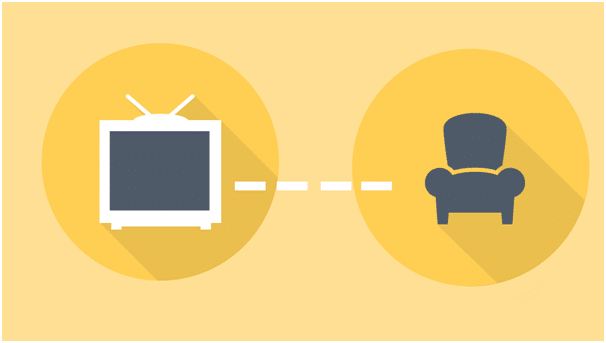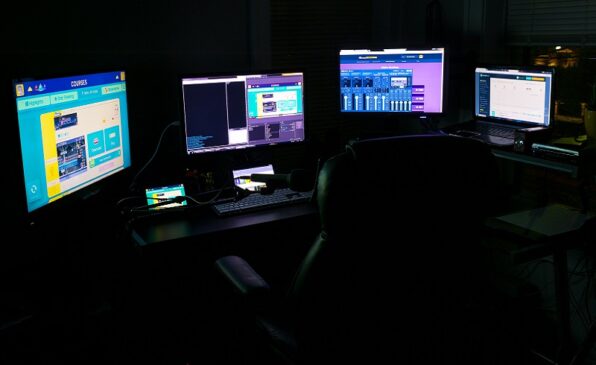TV Tip: How to Determine The Correct Seat Distance to Your TV

TechsPlace | Only the correct seat distance to your TV makes the TV experience a real visual pleasure. This guide shows you how to determine the optimum seat distance to your TV set.
Everyone has this one strange buddy: a guy who puts a 60-inch TV in his 1-room apartment. The television takes up the entire wall. Or this friend with a huge living room who simply never has a budget for technology and always takes over her friends’ old TV sets: From a distance of 6 meters, a pair of binoculars would be needed to spot anything on the 20 inch device. Both have no idea which TV size makes sense for which apartment – and how the optimum viewing or sitting distance to a TV set should be. That depends on the size of the TV. And at the same time helps to make a purchase decision for a certain device size.
Why is the seat distance important?
If you are looking for a new television, you should carefully think about the size of the set. Large – too large – televisions are also considerably more expensive than smaller sets. Because the old wisdom”Much helps a lot” does not apply to the TV size- only to a limited extent.
The distance between the seat and the TV determines the appropriate size of the TV – which is often smaller than you might initially think. Especially as the size of the electronics market is often deceptive: Due to the high ceilings and the extensive sales area, the TV sets here appear considerably smaller than later in your own home. Although such a huge TV cinema feeling comes up. This will be more like watching a film in the first cinema series – stiffness in the neck is guaranteed. The opposite is also far from ideal: If the TV is too small for the viewing distance, the picture will look like on a tablet or even a smartphone – and is far too tiny. It is therefore important to find the golden ratio.
How to determine the optimum distance to your television set

That’s why the first thing you need to do before buying a new TV is to measure distances: How far apart are the couch and TV set. How close will you be to the TV? And what type of TV resolution do you intend to buy? Samsung recommends, for example, 2.1 times the distance between the diagonal and the TV set. Sounds complicated? It’s not: You just have to use the following formula:
Diagonal in centimeters x 2.1 = optimal viewing distance in centimeters
Conversely, you can also calculate the optimum unit size in this way. All you have to do is change the formula:
Diagonal in centimetres = viewing distance in centimetres / 2.1
The diagonal in centimetres can also be easily calculated: One inch corresponds to about 2.54 cm, a 50-inch TV has a diagonal of 127 cm. Of course, this can also be reversed.
Calculation example for the ideal TV size
The further procedure is simple: Simply measure the distance from the centre of the seat of your couch (because this is typically your head) to the wall on which the TV will later be placed. The calculation does not have to be a 100% precise, so 20 to 30 cm difference are not a problem. Assuming the distance is three meters, you can enter the values in the formula:
300 centimetres / 2.1 = 142.86 centimetres
142.86 cm / 2.54 = 56.24 inches.
In concrete terms, this means that a television in the 55-inch class should be optimal for your living room. 50 or 60 inches are also OK, of course, the difference is negligible.
Optimal does not necessarily mean it has to be this way
This “optimal distance” recommended by Samsung refers to Full HD and Ultra HD content (4K). The lower resolution of HD and SD content (e.g. private channels without extra payment by cable) requires a greater viewing distance, as otherwise, the larger pixels are visible with SD content. Samsung recommends to use the factor 3 instead of 2.1, which leads to the following calculation in the above example:
300 cm / 3 = 100 cm = 39.37 inches
However, Leonardo K., researcher at Freegenday.com, adds:”If you only consume SD content, a smaller 40-inch TV is sufficient if the sofa is three metres away from the TV. But- this value no longer makes sense because streaming services such as Netflix or Amazon Video, Blu-Rays and web videos are now almost always available at least in 720p HD quality, usually even in full HD or even ultra HD resolution. The SD value can mark the “lower” edge of meaningfulness: The new TV should really not be smaller than 40 inches at a viewing distance of three meters, otherwise, the home cinema turns into a mouse cinema!”
Smaller viewing distance with Ultra-HD?
With Ultra-HD-TVs, a factor of 1.5 is often used: The high level of detail and the tiny pixels allow a significantly smaller viewing distance. In our example, the invoice would be as follows:
300 cm / 1.5 = 200 cm = 78.74 inches
So if only 4K content is consumed, an 80-inch TV would also be imaginable in our example. However, 4K content is currently still the exception rather than the rule, especially as the image quality is lousy with this device size and this viewing distance for Full HD and SD content. It is recommended to use the Full HD calculation with a factor of 2.1; this currently represents a good average value.
Consider your own preferences
Basically, the given sample calculations are of course only recommendations, which device size you ultimately decide on also depends strongly on your viewing habits. If you, like your friend from the introduction, like to sit in the middle of the action, a big TV is no problem even in small rooms. And conversely, of course, you can also buy TV sets of any size. For example, if your television is more of an information tool used for daily news than a home cinema. After all, very large panels are considerably more expensive than small ones – and you know exactly what you have to look for when you buy a device.
This article is contributed by guest author on techsplace.com.





